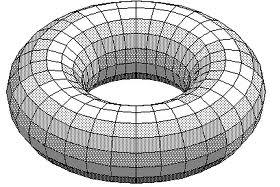Ever wonder what it would be like to play chess on a donut? Well, wonder no further: here’s a free set of simple games all redesigned to be played on a torus.
http://www.geometrygames.org/TorusGames/
A torus is a geometric surface that is basically equivalent to a donut (the surface of the donut; not the interior). One way to [theoretically] construct a torus is to take a flat piece of paper, roll it into a cylinder by gluing the two opposite edges together, and then curling the cylinder into circle and gluing the two circular ends of the cylinder together.
 So how do you play pool on a torus? As the image to the right suggests, if you shoot the ball toward the top edge of the table, it will wrap around and come out the bottom. The sides similarly wrap around, too.
So how do you play pool on a torus? As the image to the right suggests, if you shoot the ball toward the top edge of the table, it will wrap around and come out the bottom. The sides similarly wrap around, too.
This strange geometry definitely creates new strategic options in Chess and Tic-Tac-Toe, and this free set of games also include Word Search and Crossword.
A simple, thought-provoking idea. And free and fun to boot!



